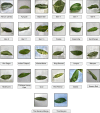Advancing mango leaf variant identification with a robust multi-layer perceptron model
- PMID: 39521776
- PMCID: PMC11550809
- DOI: 10.1038/s41598-024-74612-0
Advancing mango leaf variant identification with a robust multi-layer perceptron model
Abstract
Mango, often regarded as the "king of fruits," holds a significant position in Bangladesh's agricultural landscape due to its popularity among the general population. However, identifying different types of mangoes, especially from mango leaves, poses a challenge for most people. While some studies have focused on mango type identification using fruit images, limited work has been done on classifying mango types based on leaf images. Early identification of mango types through leaf analysis is crucial for taking proactive steps in the cultivation process. This research introduces a novel multi-layer perceptron model called WaveVisionNet, designed to address this challenge using mango leaf datasets collected from five regions in Bangladesh. The MangoFolioBD dataset, comprising 16,646 annotated high-resolution images of mango leaves, has been curated and augmented to enhance robustness in real-world conditions. To validate the model, WaveVisionNet is evaluated on both the publicly available dataset and the MangoFolioBD dataset, achieving accuracy rates of 96.11% and 95.21%, respectively, outperforming state-of-the-art models such as Vision Transformer and transfer learning models. The model effectively combines the strengths of lightweight Convolutional Neural Networks and noise-resistant techniques, allowing for accurate analysis of mango leaf images while minimizing the impact of noise and environmental factors. The application of the WaveVisionNet model for automated mango leaf identification offers significant benefits to farmers, agricultural experts, agri-tech companies, government agencies, and consumers by enabling precise diagnosis of plant health, enhancing agricultural practices, and ultimately improving crop yields and quality.
Keywords: Agricultural AI; Mango leaf identification; MangoFolioBD dataset; Multi-layer perceptron (MLP); Noise-resistant image analysis; WaveVisionNet.
© 2024. The Author(s).
Figures
















References
-
- Nkoko, N., Cronje, N. & Swanepoel, J. W. Factors associated with food security among small-holder farming households in Lesotho. Agric. Food Secur.13, 1–10. 10.1186/s40066-023-00454-0 (2024).
-
- Vuppalapati, C. Specialty Crop Mangoes. In Specialty Crops for Climate Change Adaptation: Strategies for Enhanced Food Security by Using Machine Learning and Artificial Intelligence 419–514 (Springer Nature Switzerland, Cham, 2023). 10.1007/978-3-031-38399-1_5.
-
- Rizvee, R. A. et al. LeafNet: A proficient convolutional neural network for detecting seven prominent mango leaf diseases. J. Agric. Food Res.14, 1–13 (2023).
-
- Aggarwal, K. et al. Studies on energy efficient techniques for agricultural monitoring by wireless sensor networks. Comput. Electr. Eng.113, 109052 (2024).
-
- Zhong, X., Zhang, M., Tang, T., Adhikari, B. & Ma, Y. Advances in intelligent detection, monitoring, and control for preserving the quality of fresh fruits and vegetables in the supply chain. Food Biosci.56, 103350 (2023).
MeSH terms
Grants and funding
LinkOut - more resources
Full Text Sources

